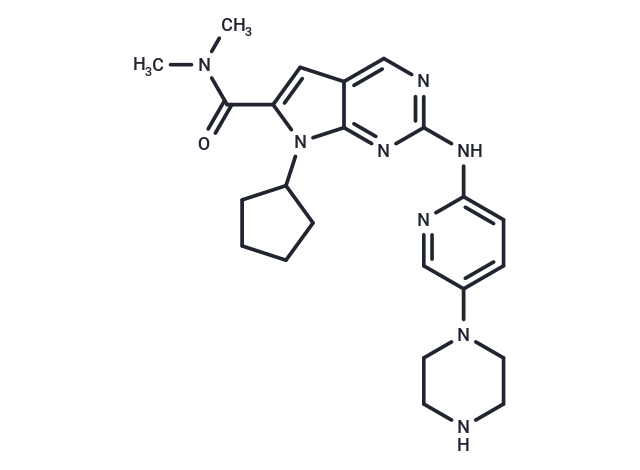Shopping Cart
- Remove All
 Your shopping cart is currently empty
Your shopping cart is currently empty

Ribociclib (LEE011) is an orally available, and highly specific CDK4/6 inhibitor (IC50:10/39 nM).

| Pack Size | Price | Availability | Quantity |
|---|---|---|---|
| 2 mg | $36 | In Stock | |
| 5 mg | $58 | In Stock | |
| 10 mg | $78 | In Stock | |
| 25 mg | $98 | In Stock | |
| 50 mg | $118 | In Stock | |
| 100 mg | $177 | In Stock | |
| 500 mg | $443 | In Stock | |
| 1 mL x 10 mM (in DMSO) | $63 | In Stock |
| Description | Ribociclib (LEE011) is an orally available, and highly specific CDK4/6 inhibitor (IC50:10/39 nM). |
| Targets&IC50 | VEGFR6:39 nM, VEGFR4:10nM |
| In vitro | LEE011 (200 mg/kg/day, p.o.) significantly delayed the growth of BE2C or 1643 cells in mice without causing weight loss or other toxic symptoms. |
| In vivo | LEE011 inhibits the growth of neuroblastoma cells, a process regulated by G1 cell cycle arrest and cellular senescence. It demonstrates significant growth suppression in 12 out of 17 neuroblastoma types evaluated, with an average IC50 of 307 nM. |
| Kinase Assay | Enzyme assays are performed using a homogeneous time-resolved fluorescence assay with recombinant epitope tagged kinase domains (JAK1, 837-1142; JAK2, 828-1132; JAK3, 718-1124; Tyk2, 873-1187) or full-length enzyme (cMET and Chk2) and peptide substrate. Each enzyme reaction is performed with or without test compound (11-point dilution), JAK, cMET, or Chk2 enzyme, 500 nM (100 nM for Chk2) peptide, ATP (at the Km specific for each kinase or 1 mM), and 2.0% DMSO in assay buffer. The calculated IC50 value is the compound concentration required for inhibition of 50% of the fluorescent signal. Additional kinase assays are performed at Cerep using standard conditions at 200 nM. Enzymes tested included: Abl, Akt1, AurA, AurB, CDC2, CDK2, CDK4, CHK2, c-kit, EGFR, EphB4, ERK1, ERK2, FLT-1, HER2, IGF1R, IKKα, IKKβ, JNK1, Lck, MEK1, p38α, p70S6K, PKA, PKCα, Src, and ZAP70[1]. |
| Cell Research | A panel of neuroblastoma cell lines, selected based upon prior demonstration of substrate adherent growth, is plated in triplicate on the Xcelligence Real-Time Cell Electronic Sensing system and treated 24 hours later with a four-log dose range of inhibitor or with a dimethyl sulfoxide (DMSO) control. Cell indexes are monitored continuously for ~100 hours, and IC50 values are determined as follows: growth curves are generated by plotting the cell index as a function of time and are normalized to the cell index at the time of treatment for a baseline cell index of 1. The area under the normalized growth curve from the time of treatment to 96 hours posttreatment is then calculated using a baseline area of 1 (the cell index at the time of treatment). Areas are normalized to the DMSO control, and the resulting data are analyzed using a nonlinear log inhibitor versus normalized response function. All experiments are repeated at least once. (Only for Reference) |
| Alias | LEE011 |
| Molecular Weight | 434.54 |
| Formula | C23H30N8O |
| Cas No. | 1211441-98-3 |
| Smiles | C(N(C)C)(=O)C=1N(C=2C(C1)=CN=C(NC3=CC=C(C=N3)N4CCNCC4)N2)C5CCCC5 |
| Relative Density. | 1.39 g/cm3 (Predicted) |
| Storage | store under nitrogen | Powder: -20°C for 3 years | In solvent: -80°C for 1 year | Shipping with blue ice. | ||||||||||||||||||||
| Solubility Information | DMSO: 50 mg/mL (115.06 mM) H2O: < 1 mg/mL (insoluble or slightly soluble) 10% DMSO+40% PEG300+5% Tween 80+45% Saline: 5 mg/mL (11.51 mM), suspension.In vivo: Please add the solvents sequentially, clarifying the solution as much as possible before adding the next one. Dissolve by heating and/or sonication if necessary. Working solution is recommended to be prepared and used immediately. Ethanol: < 1 mg/mL (insoluble or slightly soluble) | ||||||||||||||||||||
Solution Preparation Table | |||||||||||||||||||||
DMSO
| |||||||||||||||||||||

Copyright © 2015-2024 TargetMol Chemicals Inc. All Rights Reserved.